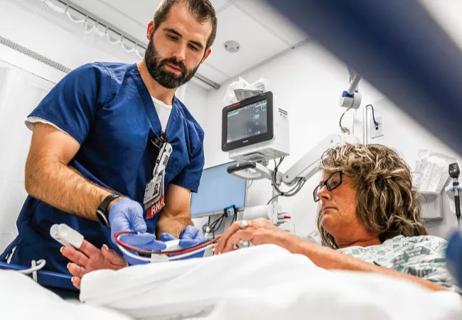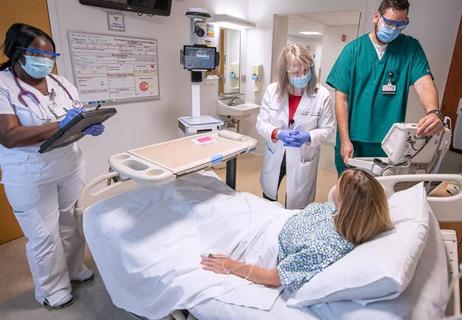Q&A with editors Mary Beth Modic and Christina Canfield

This spring, an invaluable guide for patients and their families was published. More than 40 advanced practice nurses contributed chapters to Navigating Your Hospital Stay: A Guide Written by Expert Nurses. Co-editors Mary Beth Modic, DNP, APRN, CNS, RN, CDE, and Christina Canfield, MSN, APRN, ACNS-BC, CCRN-E, shared their thoughts on the book, the role of nurses, patient advocacy and more. Modic is a CNS in diabetes at Cleveland Clinic. Canfield is the program manager for the healthcare system’s ICU Telemedicine Program.
Cleveland Clinic is a non-profit academic medical center. Advertising on our site helps support our mission. We do not endorse non-Cleveland Clinic products or services. Policy
Q: Why did you decide to write the book?
Modic: I was compelled for two reasons. One is that I’ve felt for a long time that nursing is not well represented in the public eye. If you ask people what nurses do, they will say, ‘They follow doctors’ orders’ or ‘They clean up the bodily fluids.’ So the idea behind the book was to really highlight the work of clinical nurses and how they monitor patients’ responses to treatment, protect them from injury or usher them gracefully into death. The second reason was that, as a diabetes educator, I’m always interested in what the lay public is reading and who writes it. When visiting book stores, I would come across book titles such as ‘Come Out of the Hospital Alive.’ The content in these books may be of reasonable merit, but the titles are frightening. Hospitals can be scary places for patients, and people do experience pain. But I thought the nurse, who lives where the patient lives while in the hospital, would be the best person to talk about the care that’s rendered there.
Q: What does the book cover?
Modic: It’s divided into five sections. The first orients people to the hospital environment – who’s caring for them, what their rights are, how to use technology and why the medical record is electronic. Then there’s a section on what nurses do – how they prevent infection, administer medications accurately and so on. The third section is how to manage chronic illnesses that patients are admitted for, and the fourth section covers prevalent surgeries. The last section is devoted to special populations – care of the neonate, pediatric patients, older patients, etc.
Canfield: The chapters are diverse, and they cover the entire lifespan from birth to end of life. The things we chose to include are the most common conditions that people would be admitted to the hospital for, such as cancer, respiratory issues, liver disease and diabetes. Each chapter includes information specific to that condition that would be important to know while the patient is in the hospital.
Q: You really did a fantastic job drawing on the expertise of all of Cleveland Clinic’s advanced practice nurses. Why did you feel the need to pull in all your peers?
Modic: It’s reflective of how complicated healthcare is. I couldn’t possibly write anything about heart failure because I don’t know it intimately. We have so many nurse experts here, and we wanted to tap into their knowledge. Cleveland Clinic has one of the largest teams of clinical nurse specialists in the country who are nationally and internationally recognized clinical experts.
Canfield: The authors have spent most of their careers immersed in the specialty care of these populations, so there’s no better person to speak to nursing’s unique contribution in the care of each patient population.
Modic: When I got the book, I went home and read every page. Seeing it in print and thinking of the thoughts behind the words and the intentions of the nurses writing it, I realized it was a profound gift of expertise. All the contributing authors wrote with the intention of helping patients feel safe and provide strategies on how patients and their loved ones could express their needs and concerns. This book can serve as a resource to augment what the patient needs to learn before discharge.
Q: Can you share some of the overarching advice the book provides for patients and families, no matter the reason for hospitalization or the unit they may be admitted to?
Canfield: One of the threads that weaves through every single chapter is that patients and family members should act as advocates for themselves, speak up if they think things aren’t going as planned and ask questions. The book encourages patients to take notes and be prepared for discharge. There is a discharge checklist at the end of every chapter that discusses what patients need to have in place before they go home. Do they know how to take all their medications? Do they have a follow-up appointment? Have they made modifications in their home, if appropriate? Do they have a plan if things go awry, and do they know when to call their doctor? All of that is included throughout the book along with other safety principles about avoiding injury in the hospital such as falls or complications related to their own diseases or conditions.
Q: What can nurses do to help patients and families better navigate a hospital stay?
Modic: Time is such a precious commodity in every industry, but no more so than in healthcare. The underlying genesis of the book was how the nurse needs to develop a relationship with the patient in a matter of minutes. That happens by asking additional questions aside from, ‘How long have you had chest pain?’ or ‘How long haven’t you been able to walk.’ Nurses should also ask patients about their worries, their families, concerns about going back to work and so on. Developing relationships takes time, but relationship-based nursing is incredibly important work.
Q: Is there anything else you would like to add?
Modic: Although the book is written for patients and families, I think it will have relevance for nursing students or even experienced nurses. When I read the book, I thought, ‘Oh, I didn’t know that about a person with special needs or a person suffering with Alzheimer’s.’
Canfield: What you really hear in all the chapters is each nurse’s voice. You can hear them talking to their patients. One of my chapters is on respiratory disorders. My grandfather has severe COPD, and I essentially wrote to him and my family about what I thought they would need to know. I think a lot of the authors did the same thing. This book was written out of expertise, but also written with care and love and dedication to patients and their families.

Nurses play key role in comprehensive lifetime treatment program

Compassionate care requires nurses to see beyond medical conditions to understand the complete patient

Akron General and Union Hospital increase throughput and patient satisfaction by rethinking their approach to care

Adding humor to your communication toolbox can help put patients at ease and create connections with colleagues

Aromatherapy initiative promotes a healing environment

Insight on caring for patients who lack adequate insurance, a social support system or financial stability

How clear, concise language can bridge the gap between providers and patients

Specially appointed room serves as safe space for families